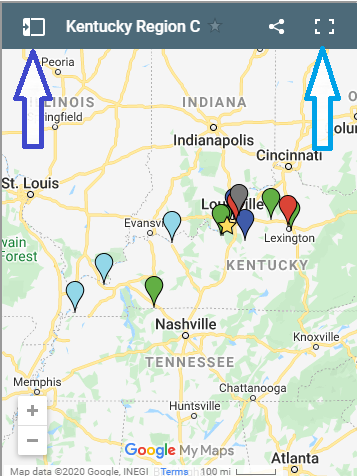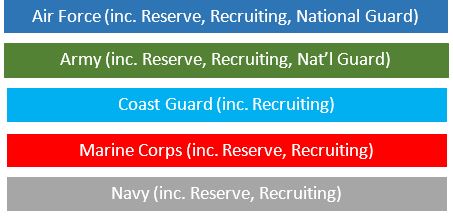State-specific information about a state’s education system is essential for relocating military families, along with how and why to contact a parent center. Parent Center staff developed this resource in collaboration with the Branch!
Continue reading ““Military Families, Welcome to Our State””Category: In Person
Region A Military Installations and Contacts
The maps help you find military installations in your state, along with contact information for Exceptional Family Member Program (EFMP) Family Support or School Liaison Office (SLO) staff in each location. For Coast Guard and National Guard locations, we have contacts for the Special Needs Program (SNP) and the Family Assistance Coordinators, respectively. Contacts who support Recruiter families are also included
Scroll down to find the mini-map for your state.
- To open the map, click on the open square icon, which is in the upper right corner of each mini-map on this page.
- In the open map you can click on a colored icon for contact information, or use the side list. You can also drag the map along on this page by placing the cursor on the map and moving the cursor when it becomes a hand.
- For just the list of installations and contacts, click on the list icon at the top left of the mini-map. If it says something like “and 55 more”, click on that phrase to open the entire list.
- When the list opens, select the installation or contact you want; information opens in a new box.
- The map and list use Google Maps for you to get directions.

The map icons represent military locations and the yellow stars are Parent Centers. The key above the maps shows how the icons are color coded by branch. Air Force is dark blue, Army is green, Marine Corps is red, Coast Guard is light blue and the Navy is battleship gray.

Download map information as a Word docx.:
Connecticut Delaware District of Columbia Maine Maryland Massachusetts New Hampshire
New Jersey New York Pennsylvania Puerto Rico Rhode Island US Virgin Islands Vermont
Region C Military Installations and Contacts
The maps help you find military installations in your state, along with contact information for Exceptional Family Member Program (EFMP) Family Support or School Liaison Office (SLO) staff in each location. For Coast Guard and National Guard locations, we have contacts for the Special Needs Program (SNP) and the Family Assistance Coordinators, respectively. Contacts who support Recruiter families are also included.
Scroll down to find the mini-map for your state.
- To open the map, click on the open square icon, which is in the upper right corner of each mini-map on this page.
- In the open map you can click on a colored icon for contact information, or use the side list. You can also drag the map along on this page by placing the cursor on the map and moving the cursor when it becomes a hand.
- For just the list of installations and contacts, click on the list icon at the top left of the mini-map. If it says something like “and 55 more”, click on that phrase to open the entire list.
- When the list opens, select the installation or contact you want; information opens in a new box.
- The map and list use Google Maps for you to get directions.

Download map information as a Word .docx:
Illinois Indiana Iowa Kansas Kentucky Michigan Minnesota Missouri Montana Nebraska North Dakota Ohio South Dakota Wisconsin West Virginia Wyoming
Region D Military Installations and Contacts
The maps help you find military installations in your state, along with contact information for Exceptional Family Member Program (EFMP) Family Support or School Liaison Office (SLO) staff in each location. For Coast Guard and National Guard locations, we have contacts for the Special Needs Program (SNP) and the Family Assistance Coordinators, respectively. Contacts who support Recruiter families are also included.
Scroll down to find the mini-map for your state.
- To open the map, click on the open square icon, which is in the upper right corner of each mini-map on this page.
- In the open map you can click on a colored icon for contact information, or use the side list. You can also drag the map along on this page by placing the cursor on the map and moving the cursor when it becomes a hand.
- For just the list of installations and contacts, click on the list icon at the top left of the mini-map. If it says something like “and 55 more”, click on that phrase to open the entire list.
- When the list opens, select the installation or contact you want; information opens in a new box.
- The map and list use Google Maps for you to get directions.

Download map information as a Word .docx:
Arizona Alaska California Colorado Hawaii Idaho New Mexico Nevada Oregon PACIFIC BASIN Utah Washington
Region B Military Installations and Contacts
The maps help you find military installations in your state, along with contact information for Exceptional Family Member Program (EFMP) Family Support or School Liaison Office (SLO) staff in each location. For Coast Guard and National Guard locations, we have contacts for the Special Needs Program (SNP) and the Family Assistance Coordinators, respectively. Contacts who support Recruiter families are also included.
Scroll down to find the mini-map for your state.
- To open the map, click on the open square icon, which is in the upper right corner of each mini-map on this page.
- In the open map you can click on a colored icon for contact information, or use the side list. You can also drag the map along on this page by placing the cursor on the map and moving the cursor when it becomes a hand.
- For just the list of installations and contacts, click on the list icon at the top left of the mini-map. If it says something like “and 55 more”, click on that phrase to open the entire list.
- When the list opens, select the installation or contact you want; information opens in a new box.
- The map and list use Google Maps for you to get directions.

Download map information as a Word .docx:
Alabama Arkansas Florida Georgia Louisiana Mississippi North Carolina Oklahoma South Carolina Tennessee Texas
What Does a Parent Center Do?
Federally funded Parent Training and Information Centers (PTIs) are found in every State, the District of Columbia, Puerto Rico, and the Virgin Islands. Large States have more than one PTI. In addition, thirty federally funded Community Parent Resource Centers (CPRCs) focus on unserved or underserved populations throughout the United States and territories. Together, the PTIs and CPRCs (collectively referred to as Parent Centers) can play a vital role in supporting your work with Exceptional Family Members in your communities. The following information is a quick fact sheet on what a federally funded Parent Center is required to do through their grants and some suggestions on how you can utilize them effectively.
Medicaid: Referring Military Families to Supports and Services
Military families have unique concerns around the supports and services needed by their child with special needs. On the one hand, they have guaranteed medical coverage through TRICARE, the military health care system and its range of special programs. On the other, there are distinct limits to coverage and programs which may leave military families without some essential supports and services. Medicaid can be an option for some military families which they may not have considered, and which Parent Center staff can help them explore.
Continue reading “Medicaid: Referring Military Families to Supports and Services”
Interstate Compact on Educational Opportunities for Military Children
The Interstate Compact on Educational Opportunities for Military Children was created to provide a smooth transition for military children as their families relocate from installation to installation. “While the Compact is not exhaustive in its coverage, it does address the key issues encountered by military families: eligibility, enrollment, placement and graduation” (NCSL, 2014). The Compact has been created with the hope that students will not lose academic time in transition, obtain an appropriate placement, and be able to graduate on time. Currently, all 50 states and District of Columbia participate in the Compact. Continue reading “Interstate Compact on Educational Opportunities for Military Children”
How to Use Military Rank and Insignia
The U.S. Armed Forces use rank and insignia to classify and categorize each service member from Private to General. Learning how to recognize and use these identifiers will help the Parent Center staff when working with installation service members.
What does this mean to the Parent Center? A member’s rank/insignia is where they are in the chain of command, what leadership responsibilities they have.
Relocation (“PCS”) for Military Families-with handout!
Relocation affects many aspects of life for military families including housing, nonmilitary spouse employment, schools and activities for children, childcare, and services for children with special needs.
Continue reading “Relocation (“PCS”) for Military Families-with handout!”

